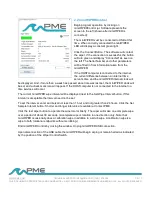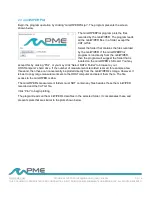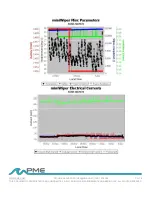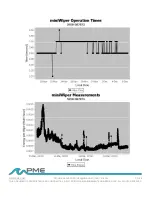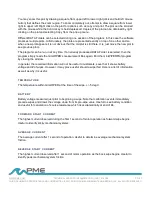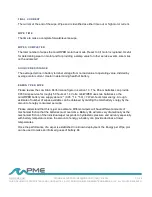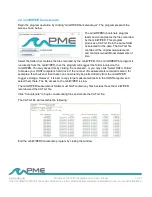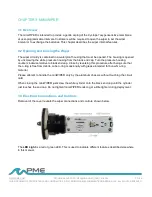
TECHNICAL SUPPORT: INFO@PME.COM | (760) 727-0300
PG. 9
THIS DOCUMENT IS PROPRIETARY AND CONFIDENTIAL. © 2021 PRECISION MEASUREMENT ENGINEERING, INC. ALL RIGHTS RESERVED.
1.3 Wipe Considerations
B R U S H F O R C E
The amount of force placed by the brush onto the optical surface depends on how closely the brush
is positioned against the foil. There is a trade-off here which is selected by adjusting the brush
against the optical surface. Scrubbing organisms from the surface is hard on the organisms (which is
a good thing) but also hard on the surface itself. The surface should resist more than a year of
hourly gentle scrubbing. Brush pressure and wipe interval must ultimately be selected to respond to
local fouling conditions.
You may have to adjust the brush position from time to time as the brush wears. The brush will likely
require replacement from time to time.
W
IPING AND
R
ECORDING
I
NTERVAL
–
At each wipe miniWIPER makes various measurements of
internal features and records these. The default wipe interval is 6 hours. However, it is also possible
to instruct the miniWIPER to wipe and record at different intervals. This is accomplished by running
the miniWIPERControl.jar program supplied with the miniWIPER. Recording intervals must be 1 or
more hours and must be less than or equal to 24 hours. Intervals outside this range will be rejected
by the miniWIPERControl program. (Contact PME for other recording intervals.)
Please refer to Chapter 2 for instructions on operating the miniWIPERControl program.
T IM E
All miniWIPER times are UTC (formerly known as Greenwich mean time (GMT)). The miniWIPER
internal clock will drift in the <10 ppm range (< about 30 seconds/month) so you should plan to
connect it occasionally to a HOSTcomputer having an Internet connection. The miniWIPERControl
program will automatically set time based on an Internet time server.
Please refer to Chapter 2 for instructions on operating the miniWIPERControl program.
F I L E I N F O R M A T I O N
The miniWIPER software creates 1 file daily on the miniWIPER's internal SD card. The number of
wipes recorded in each file will depend upon the wipe interval. Files are named by the time of the
first measurement within the f
ile based on the miniWIPER’s internal clock and expressed in YYYY-
MM-DD HHMMSSZ.txt format. For example, a file having the first measurement on September 9,
2020 at 17:39:00 UTC will be named 2020-09-09 173900Z.txt.
Files can be uploaded from the miniWIPER by connecting it to a HOSTcomputer. Use the
HOST
computer’s copy/paste functions to move the files from the miniWIPER to the HOSTcomputer.
Each wipe recording within the files has a time stamp. The time stamp format is Unix
Epoch 1970, the number of seconds that have passed since the first moment of

















